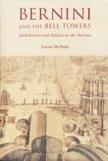What of St. Peter's Facade?
In case you have ever wondered why the facade of St. Peter’s Basilica in Rome seems so disproportionately and disagreeably wide in relation to its height, the explanation is that the final bays on both of its sides are in fact not part of the facade itself. They instead represent the lower portions of two bell towers that were begun in the early 17th century but never finished, despite great outpouring of time, money, materials and artistic genius. (The two other great defects of the facade are that its infelicitous height obscures a proper view of Michelangelo’s magnificent dome and that one of the Counter-Reformation rebuilders of St. Peter’s, the Borghese Pope Paul V, shamelessly carved his own name in big bold letters over its entrance, as if the church were dedicated to him and not the Prince of the Apostles.) The artistic genius commissioned by Pope Urban VIII to complete the bell towers was the Baroque sculptor-architect-painter Gianlorenzo Bernini, to whose numerous churches, chapels, altars, palaces, statues, fountains and other monuments the city of Rome owes much of its present physical appearance and emotional charge.
Between 1638 and 1643 Bernini’s two towers, lofty and elegant, slowly came into being. The south (left-hand) tower reached virtual completion, while construction of its northern counterpart was interrupted by the financial calamity provoked by the so-called War of Castro, Urban’s reckless, cupidity-driven campaign against the Farnese family. But even before suspension of work on the towers, several disturbingly large cracks began to appear on the facade and on the vault of the Benediction Loggia, the second-floor gallery from which every newly elected pope makes his first appearance to the world. Bernini’s enemies rushed to put the blame on himand him alonefor making the towers too high and heavy and not conducting proper testing of the foundations before initiating construction. Then and throughout subsequent generations the truth of the matter remained obscured, Bernini’s name tarnished by this egregious and costly failure.
Now for the first time, Sarah McPhee, associate professor of art history at Emory University, painstakingly reconstructs the long and complicated unfolding of this entire affair and sets the record straight on many previously unknown, misunderstood or misinterpreted points. First undertaken as a doctoral dissertation at Columbia University, MacPhee’s investigation of the bell tower fiasco represents the fruit of much intense, insightful research in archives and libraries in Rome and elsewhere in Europe. Based on her remarkable expert knowledgetechnical, historical and aestheticof the physical fabric of St. Peter’s, Bernini and the Bell Towers is an awe-inspiring, laudable monument of scholarship, worthy of its subject.
Scrutinizing the entire history of the facade’s design, construction and its intended symbolic meaning, McPhee leaves no stone unturned, proving along the way that responsibility for the failure of the towers was not Bernini’s. The blame belongs, above all, to Carlo Maderno, his predecessor as architect of St. Peter’s, who initiated the towers on weak foundations (of his own creation), and to Pope Urban, who pressed Bernini to produce an increasingly ambitious, and increasingly heavy, design.
Though well written and amply illustrated with numerous photographs (some in color) and reproductions of drawings and engravings, McPhee’s book is not for the light of heart nor the casual tourist-reader; it is an extremely detailed, technical investigation and closely reasoned analysis of the facts and previous interpretations. The text is supplemented by an extensive appendix of the principal documents, most of them unpublished, on which the argument advanced in the text rests, as well as a catalogue raisonné of drawings relating to the bell tower competition of 1645-46.
McPhee’s book will long remain the definitive study on this topic. Her research appears exhaustive and her scholarly analysis impeccable. My only point of disagreementand the point is a small oneis with her characterization of this bell tower affair as the single instance of failure in the otherwise brilliant career of Gianlorenzo Bernini. In fact, Bernini’s work in Paris was a whopping failure. The artist was summoned there in 1665 to design the new Louvre by King Louis XIV. Bernini’s several designs for the Louvre were rejected and ridiculed, and his suggestions for other smaller architectural projects ignored. Thanks to his own paranoid narcissism and ill-hidden contempt for the French and French architecture, Bernini alienated nearly all of his French hosts, including the king and his powerful minister, Colbert. Later, when Bernini’s equestrian portrait of Louis arrived in Paris, the king disliked it so much that he wanted it destroyed on the spot. Instead, a French artist resculpted it into an image of Marcus Curtius, and it was consigned to a less glorious location in the park of Versailles.
But to get back to the story of the towers. Alas, Bernini’s exquisite creations were totally demolished, despite the fact that they could have been saved, albeit with a costly and complicated amount of retrofitting. A further competition for the design of new towers was held soon thereafter but came to naught. And so, to this day, St. Peter’s remains deprived of its final architectural perfection, a pair of proper bell towers, elegant, soaring to the heavens, gracefully proportionate to the basilica’s otherwise ponderous, cumbersome facade. These things, dear reader (as a 19th-century English novelist might remind us), are allegory.
This article also appeared in print, under the headline “What of St. Peter's Facade?,” in the April 21, 2003, issue.








